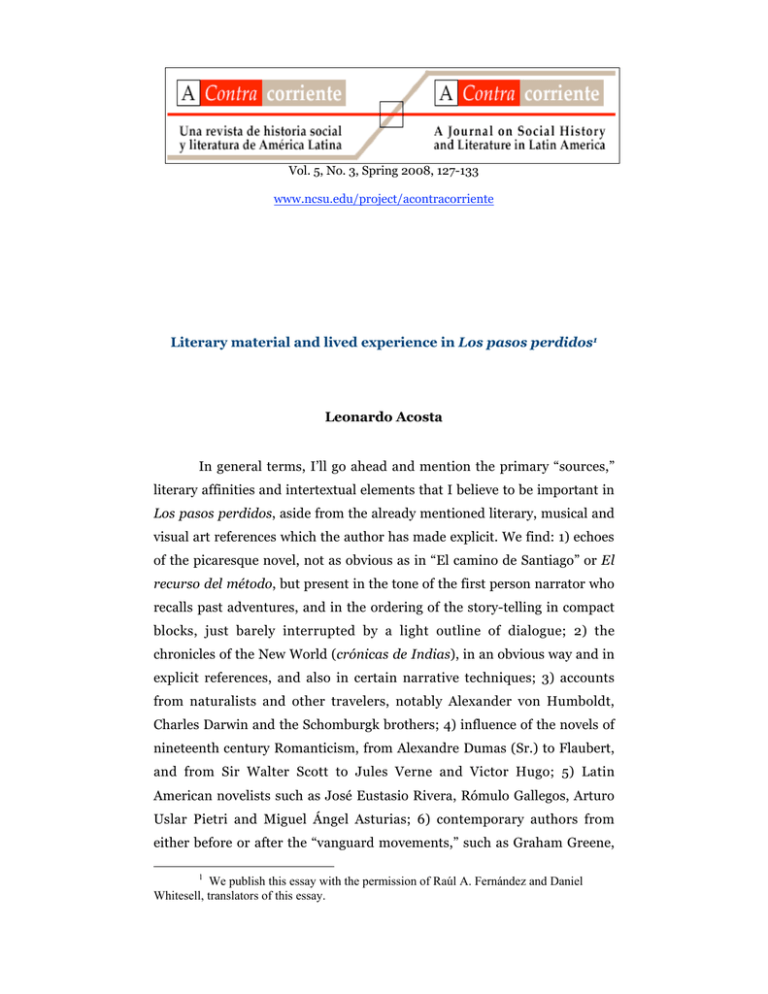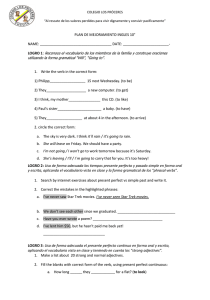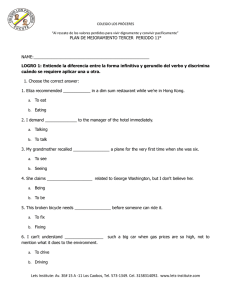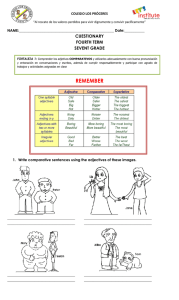Acosta sobre Carpentier
Anuncio

Vol. 5, No. 3, Spring 2008, 127-133 www.ncsu.edu/project/acontracorriente Literary material and lived experience in Los pasos perdidos1 Leonardo Acosta In general terms, I’ll go ahead and mention the primary “sources,” literary affinities and intertextual elements that I believe to be important in Los pasos perdidos, aside from the already mentioned literary, musical and visual art references which the author has made explicit. We find: 1) echoes of the picaresque novel, not as obvious as in “El camino de Santiago” or El recurso del método, but present in the tone of the first person narrator who recalls past adventures, and in the ordering of the story-telling in compact blocks, just barely interrupted by a light outline of dialogue; 2) the chronicles of the New World (crónicas de Indias), in an obvious way and in explicit references, and also in certain narrative techniques; 3) accounts from naturalists and other travelers, notably Alexander von Humboldt, Charles Darwin and the Schomburgk brothers; 4) influence of the novels of nineteenth century Romanticism, from Alexandre Dumas (Sr.) to Flaubert, and from Sir Walter Scott to Jules Verne and Victor Hugo; 5) Latin American novelists such as José Eustasio Rivera, Rómulo Gallegos, Arturo Uslar Pietri and Miguel Ángel Asturias; 6) contemporary authors from either before or after the “vanguard movements,” such as Graham Greene, 1 We publish this essay with the permission of Raúl A. Fernández and Daniel Whitesell, translators of this essay. Acosta 128 André Malraux, Ramón del Valle-Inclán, Hermann Broch and more specifically Thomas Mann and Malcolm Lowry; 7) surrealism; 8) Borges, Kafka, and others. This enumeration does not imply an order of importance nor is it meant to be comprehensive. It’s rather a reminder of the intertextual richness that has been insufficiently explored in Carpentier and of the great interest that the search for possible “literary models” holds. Also, recalling the well known remark that “books are born from other books,” so important to Jorge Luis Borges and Umberto Eco, I think it’s necessary to dispell the myth of an Alejo who by merely traveling up the Orinoco River and seeing with his own eyes the vastness of the Great Plain, was capable of creating almost ex nihilo a novel that is so revolutionary and at the same time of such complexity. Of course, Alejo’s personal experience in Venezuela is of considerable importance for the conception and realization of this novel in particular, and we have his travel reports and personal accounts, but we also have the valuable contribution of an exceptional observer, well known in Cuba and in Venezuela: the musician Hilario González. This composer and music researcher, who knows Carpentier’s work and life better than most, accompanied the novelist in his expedition up the Orinoco, and he has reviewed the elements of reality and personal experience during this trip from which came a number of key ideas for Los pasos perdidos. In fact, Alejo made three trips, and Hilario participated in the last two. On the second one, up the Orinoco, the Venezuelan musician Tony de Blois Carreño, grandson of the pianist Teresa Carreño, goes along as well, and it seems to have been more fun than the novel would lead us to believe. According to Hilario, Alejo read the novel to both musicians before sending it in to the publisher, and Hilario came to the conclusion that the main character “is drawn from the bahavior, events and experiences that Tony de Blois, he and I had during the second trip.” In spite of all the stories he tells, as well as information of great use in understanding and locating the genesis of this exceptional novel, perhaps Hilario is being a bit too modest, because according to all the accounts that I have been able to find, the musician who set out to find the indigenous instruments—the basic motif of the novel—was Hilario González himself. Los pasos perdidos 129 Trips to the Great Plain and the Orinoco Nevertheless, Hilario provides us with excellent first hand information on the trips that Carpentier took within Venezuela in 1948-1950. On the first trip, Hilario comments, Alejo flew over the Great Plain and saw the big rivers, the giant Tepuy, Angel Falls [...], he became familiar with Santa Elena de Uairén, he visited Ciudad Bolívar... and he returned to Caracas amazed. It’s what he recounts in his five chronicles published in Carteles, between January and June of 1948. And Hilario continues in his narration, obviously more extensive and explanatory than the “Note” that Alejo includes at the end of Los pasos perdidos as a kind of epilogue (and which might seem unnecessary): On the second trip, in the summer of 1948, we, Tony de Blois and I, accompanied him. We left Caracas by ground and we crossed the entire plain up to the Orinoco. From there we jumped to Upata (the same town that Rómulo Gallegos mentions in Canaima). We returned to Ciudad Bolívar and we traveled in a tug boat to Puerto Ayacucho. We then took a canoe and went on the Orinoco to the island of Ratón [...]. After that we continued canoeing and went into the jungle via the Guacharaca estuary—where there are V shaped incisiones on a tree—to reach the village of Guahíbe Indians, last point on the journey, in Amazon territory. And there’s a third trip, two years later, that we took in the opposite direction, toward Colombia, going up into the Andes: the Páramo de la Negra, Apartaderos, Tovar, Bailadores, Mesa de Esnujaque, and the Páramo de Macuchíes, where the Eagle monument is, which marks the spot where Bolívar crossed the Andes. When I showed these passages of Hilario along with the note-epilogue of Alejo to a Venezuelan historian who knew the geography and ethnology of his country very well, he raised a few objections, of which I’ll only mention one: the impossibility that they could have traveled via the Orinoco river from Ciudad Bolívar to Puerto Ayacucho. And after drawing a map of the region, attached to it he left me this written explanation: There is a stretch—before getting to Puerto Ayacucho, originally Puerto Perico—called the Atures Falls that prevents navigation. What brought about the construction of the Puerto AyacuchoSamariapo highway is precisely the presence of these falls (Atures and Maypures). Alejo must have traveled to Puerto Páez, on the borderline between the state of Apures and Amazonas. He traveled by ground to Ayacucho and Samariapo. In this last town he gets on Acosta 130 a boat and goes up the Orinoco. He must have discovered the marvelous tributaries of the Cuao, Autana and Sipapo rivers. Anyway, Hilario’s memory is surprising, particularly when we consider that Alejo forgot this detail, which reinforces the argument maintained by the researchers Roberto González Echevarría and Antonio Benítez Rojo—and with whom I agree—on the importance of the books of renowned travelers that Carpentier referred to when he wrote the chapters on his “trip to the jungle” in Los pasos perdidos. With respect to Hilario’s version, the only thing I don’t agree with is his emphatic insistence that in the novel “everything is an artistic rendering of reality,” including not only the places and the landscape, but also the characters. For it’s precisely in this novel of the “real maravilloso” that there is much more literature than what a first (or second) reading would lead us to believe. When he identifies the characters, Hilario indicates that the young Black painter is the Cuban Roberto Diago, and the Indian poet the Venezuelan Mateo Manaure. The ballet company that is caught in the hotel during a coup d’etat (Pérez Jiménez) was Alicia Alonso’s in the Hotel Majestic in Caracas. The harpist would be, at least in part, Juan Vicente Torrealba, and so on. For example, the Greek Yannes appears along with Hilario in one of the photos that illustrate his account. In real life his name was Yannis Metakos, a diamond explorer, who always traveled with a copy of the Odyssey and Xenophon’s Anabasis. Alejo and Hilario made friends with this character in Ciudad Bolívar, in real life he had a Macedonian father and a Turkish mother. Rosario, whose figure is the encarnation of the utopic mestizaje of all the races of the Americas, so dear to Carpentier, would be the combination of a teacher, María de las Nieves, who accompanied them on one stretch of the second trip, and an Indian woman whom they picked up in the Páramo de la Negra on their way into the Andes, the place described in Chapter III. The capuchin Brother Pedro de Henestrosa is mentioned by Alejo in his chronicles by his real name, Brother Diego de Valdearenas. And the character of The Adelantado2 is taken from the visit on his first trip to Santa Elena de Uairén. The Adelantado was actually Lucas Fernández Peña, 2 The Adelantado was an important member of expeditions to the New World who was invested by the crown with powers to stake out new claims and found cities. Los pasos perdidos 131 one of the founders of that village which Carpentier turned into the mythical Santa Mónica de los Venados, which may or may not be the Utopia that so many astute researchers have conjectured. For now let’s stop to consider The Adelantado, a much more important figure than what he appears to be at first glance, and who is juxtaposed with the protagonist, as well as with the Greek diamond explorer. In the sixth and final chapter of the novel the protagonist-narrator reflects: “Through The Adelantado I’ve learned that the highest goal facing a human being is that of forging your destiny.” Here we have the topic of Destiny clearly expressed, present in all of Carpentier’s novels and faithful to the precepts of Miguel de Montaigne. But the role of The Adelantado appears more clearly in the chronicle “The last searcher for El Dorado,” which ends with this revealing paragraph: This adventurer who came walking in search of the legendary El Dorado, left behind him, more than twenty years ago, a fragile reality of dungeons, adulation and asafetida, to find, in this [village of] Santa Elena de Uairén, under a thatched roof, together with the woman from Genesis, a Utopia fitting his mysterious calling, his deepest desires. According to a fundamental law of alchemy, “Only those who do not profit from the gold obtained, shall be worthy of discovering the secret of the transmutation of the metals”. This hidden law is, most likely, the real secret of El Dorado. Here a number of topics and motifs come together: those of Destiny, the Trip to the world of Genesis (traveling through time), Utopia and alchemy in relation to the search for El Dorado. The Adelantado is the character in Los pasos perdidos who successfully forges his own destiny, the Founder of Cities, who triumphs over Yannes the Greek and over the protagonist himself, who will see his own destiny “deformed” when he has to leave the recently discovered Utopia, which had bedazzled him, and return to the “civilized” world of the Apocalypse. But I shouldn’t get ahead of myself: what I would like to make clear at this point is that none of the characters from Los pasos perdidos are simply copies of corresponding real life people, as Hilario González puts forth, for even Lucas Fernández Peña, whose identification with The Adelantado is unmistakable, is at the same time a character-symbol, as are the majority of Carpentier’s characters in any of his novels. Nevertheless, The Adelantado’s three daughters, after whom three villages are named, are mentioned as real in his chronicles, but Acosta 132 neither he nor Hilario can identify his son Marcos, and the reason they can’t is because he is a literary character, taken from the Marcos Vargas who appears in Rómulo Gallegos’ Canaima, an obvious tribute to the Venezuelan predecessor. Another character not identified with a real life person is Montsalvaje, the Herbist, who is at the same time an herb expert, an alchemist, with traits of chamán or piache, a medicinal healer (curandero), a sorcerer (hechicero) and even a type of Doktor Faustus of the Jungle. His very name is a pure literary and symbolic creation; and how can we forget the omnipresent Gavilán, the Adelantado’s dog? It obvious that it’s not there on a simple whim of the novelist. But we still need protagonists, and one of them is Mouche, identified literarily as a follower of the surrealist circles and interested in astrology. Hilario tells us something of her in an evasive way: Mouche is an invented character, the French lover of the protagonist. Because there were no women who traveled with us. But the character type is a real person and the elements of her apartment in Paris, the astrology passage, all that, was part of real life in Paris as well as New York, which are the cities from which Alejo patterns his big city at the beginning of the novel. It has elements of Paris and elements of New York. The comparison between Paris and New York would be valid except for the fact that we’re talking about Alejo Carpentier, who had lived for more than a decade in Paris and never in New York, where he would only stay briefly in passing. Also, Hilario contradicts himself when he says that the character is “invented” but that “the character type is a real person.” Any literary critic or writer who lived in Havana would identify Mouche with an ex-wife of Alejo, the French Eva Fréjaville, even though the story line has nothing to do with her and she was combined with other literary references; González Echevarría has suggested the names of Camille Seldon and Elise von Krienitz, a lady friend of Heinrich Heine. The protagonist or Musician-Explorer is also not the sum of Alejo plus Hilario plus Tony de Blois, and much less the novelist himself, who has taken great care to maintain a distance between himself and his protagonist, which seems obvious to me. Nevertheless, there is a key character in the novel about whom we are told nothing—neither from the author nor from his friend and Los pasos perdidos 133 traveling buddy—, because she’s a figure who is essentially symbolic and functional to the effects of the story: I’m referring to Ruth, about whose unsociable presence I will attempt to develop my own thesis. In brief, almost at the end of his note-epilogue to Los pasos perdidos, Carpentier attempts to persuade us that The Adelantado, Montsalvaje, Marcos, Brother Pedro, are the characters found by anyone who travels in the great theater of the jungle. They all reflect a certain reality—just as a certain myth of El Dorado reflects a reality, a myth which is still fed by deposits of gold and precious stones. The words of Hilario González are similar when he states that the characters “all reflect a [certain] reality.” We’ve seen that this isn’t so. But Carpentier, when he adds that “a certain myth of El Dorado” also reflects reality, he is giving us an instance of the ‘real maravilloso’ in action. Because if myths reflect a real life situation, although perhaps only in certain contexts of place and time, among others, any narrative discourse can stay within the parameters of the real world, or of any category of realism. What is evident to me is that the novelist has hidden the main clues to the puzzle, while he distracts us—and leads us astray—with the final note and with many of the educated references that multiply throughout the book and that, while they fulfill a very specific function, sometimes fill the novel (as happens with a later work, El recurso del método), and they mask its deepest meaning, constituting a sort of “false intertextuality,” a kind of false jewelry façade behind which the real jewels are hidden.








